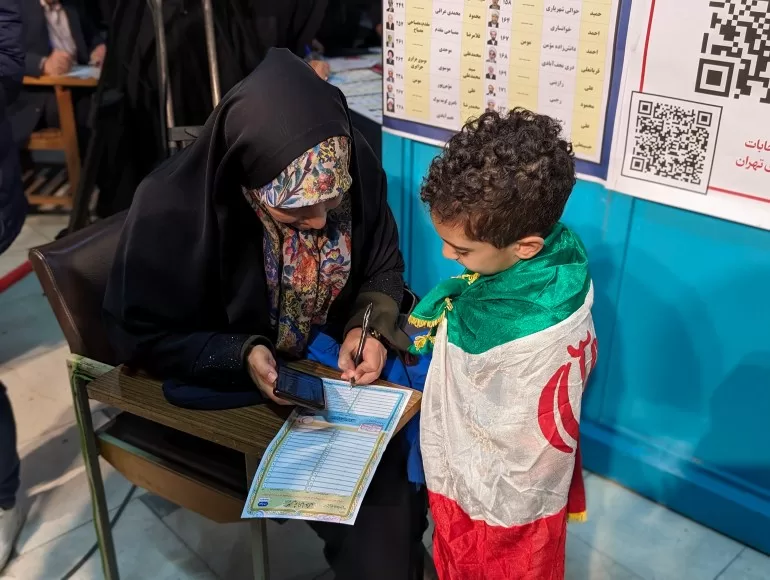Final vote counting is under way after millions went to the polls on Friday to select 290 lawmakers and 88 members of the Assembly of Experts, a body tasked with choosing the supreme leader made up entirely of Islamic scholars.
Official preliminary results from Tehran on Saturday indicate that ultraconservatives Mahmoud Nabavian and Hamid Resaee have topped the list of 30 representatives, followed by 35-year-old state television host turned first-time lawmaker, Amir Hossein Sabeti.
Parliament chief Mohammad Bagher Ghalibaf finished fourth, and only a handful of his sponsored candidates ascended. Longtime lawmaker Mojtaba Zonnour grabbed a seat in the holy Shia city of Qom.
Few reformist or moderate voices managed to secure entry into parliament, marking the second parliamentary election in which they were largely absent.
Veteran lawmaker Masoud Pezeshkian was among few moderates who managed to get approved by the constitutional watchdog Guardian Council and secure votes, and will represent Tabriz in the 12th parliament.
Ali Motahari, conservative former parliamentarian and son of renowned late scholar Morteza Motahari, who has become a more moderate politician compared with other legislators, failed along with most members of his 30-strong list for Tehran to come close to securing a seat.

President Ebrahim Raisi comfortably renewed his place at the Assembly of Experts for a third time, securing more than 82 percent of the vote in the South Khorasan province located in eastern Iran.
The president was initially running without any opponent after the Guardian Council disqualified other candidates, but one candidate ended up changing his district to ceremonially run against Raisi for a place in the sixth term of the assembly, which will last till mid-3032.
Ultraconservative Ahmad Khatami, a current imam of Friday prayers in Tehran, has again secured a place at the assembly from the province of Kerman, and Mohammad Saeedi is Qom’s representative.
Local media said with over 834,000 votes, Mohammad Ali Ale-Hashem, the supreme leader’s representative in Tabriz, recorded the highest number of votes ever for an assembly winner, emerging victorious in the province of East Azerbaijan.
Sadegh Amoli Larijani, a senior member of the influential Larijani family and current head of the top arbitration body known as the Expediency Council, was perhaps the most notable snub from the assembly.
Candidates have until Thursday to formally declare any complaints, Guardian Council spokesman Tahan Nazif said on Saturday.
All about turnout
The elections were held across 59,000 voting stations across Iran, with 6,800 in the province of Tehran, which includes the capital and several surrounding cities.
The Ministry of Interior extended voting time three times, until midnight on Friday, sending text messages to voters that a “rush” of people at polling stations has kept them open.
But many conversations surrounding the elections, whether for or against, were marked by discussions around low turnout in the first elections since the country’s 2022-2023 nationwide protests and as Iran’s economy – squeezed by United States sanctions – has continued to grapple with high inflation.
Results are not final yet, but state-linked media reported on Saturday that some 25 million Iranians voted, which they hailed as a “huge defeat” for what they called a campaign to boycott the elections run by anti-establishment elements.
The Islamic Revolutionary Guard Corps (IRGC) on Saturday thanked Iranians for their “glorious” participation in the elections in a statement, saying it was a “decisive response to enemies”.
That number would put turnout at about 40 percent of 61.2 million eligible voters, roughly on par with the 2020 election which had put lawmakers into parliament with a 42-percent turnout, the lowest in the history of Iran since the country’s 1979 revolution.
In Tehran, a city with some 7.7 million eligible voters, roughly a quarter are believed to have voted, pending final results.
Iran’s currency, the rial, continued to fall on Saturday, extending a downward trend since the start of 2024 that has in part reflected concerns over expanding military confrontations between the “axis of resistance” supported by Iran across the region and the coalition led by the US.
The rial hit a low of around 600,000 per the US dollar in the open market at the start of the Iranian week on Saturday, a figure it had dipped to in late February 2023 before regaining some ground.
